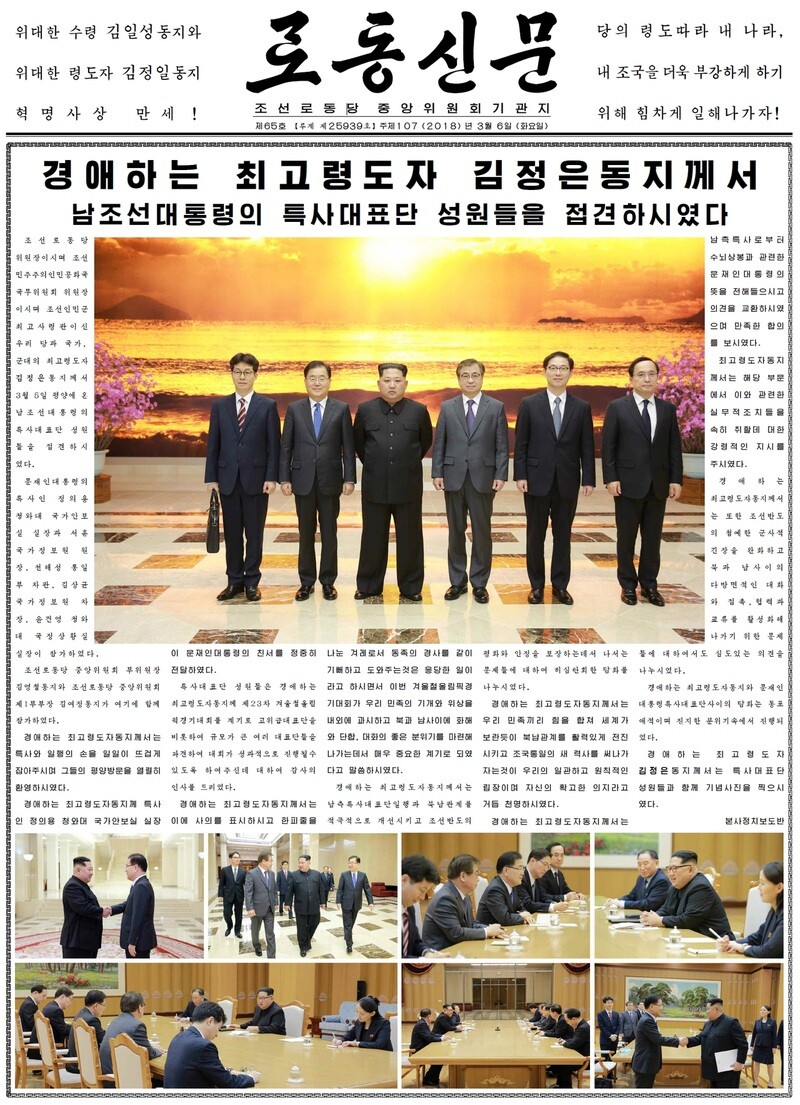hankyoreh
Links to other country sites 다른 나라 사이트 링크
South and North Korea to set up a communications hotline between President Moon and Kim Jong-un

In addition to laying the groundwork for an inter-Korean summit next month, the achievements of a recent North Korea visit by a South Korean special envoy’s delegation include the two sides’ announcement of plans to install a communications hotline between their leaders and Pyongyang’s explicit declaration that it will not use nuclear or conventional weapons against the South.
“South and North agreed to [re-establish] a communications hotline between leaders to reduce military tensions and allow for close discussions,” special envoy and Blue House National Security Office director Chung Eui-yong said in a Mar. 6 press conference at the Blue House’s Spring and Autumn Pavilion press center.
“We plan to have the first call take place before the third inter-Korean summit [scheduled to take place at the end of April],” Chung added.
Installation of a hotline would allow South Korean President Moon Jae-in and North Korean leader Kim Jong-un to call each other at any time as needed, instituting a permanent, top-level channel for the two sides to prevent unnecessary military clashes and tension-raising.
“A communications hotline established between the South and North Korean leaders stands to contribute greatly to preventing unintended military clashes on the Korean Peninsula, and could also be seen as enabling ongoing communication under regular circumstances,” said Peace Network director Cheong Wook-sik.
Former Unification Minister Lee Jong-seok described the hotline’s establishment as being “of very great significance as an expression of Kim Jong-un’s commitment to ushering inter-Korean relations from hostility to an ordinary and normal relationship conforming to international standards.”

A communications hotline between the South and North Korean leaders was previously established following the first inter-Korean summit between then-President Kim Dae-jung and North Korean leader Kim Jong-il in June 2000. In his book “Peacemaker,” former Unification Minister Lim Dong-won wrote, “The emergency contact network between the two leaders continued in place until the last day of the [Kim Dae-jung] administration and served a very important role in resolving inter-Korean issues. Personally, I see the establishment of this ‘hotline’ as one of summit’s greatest achievements.” The hotline between the two leaders continued through the Roh Moo-hyun administration (2003–08) before being discontinued under President Lee Myung-bak (2008–13).
North Korea also sent the clear message that it would not be resuming nuclear and ballistic missile testing or other strategic provocations while dialogue is going on and made a “firm promise not to use nuclear or conventional weapons against the South,” Chung reported. The message, which essentially makes clear that North Korea intends its nuclear weapons as a means of responding to the US military threat, is predicted to contribute to reducing fears of a nuclear attack against the South.
The statement that the North does not plan to use conventional weapons either reads as an overt promise to refrain from provocations along the lines of the Yeonpyeong Island artillery attack in 2010, which is expected to have a practical effect in terms of preventing military clashes between the two sides.
By Seong Yeon-cheol, staff reporter
Please direct questions or comments to [english@hani.co.kr]

Editorial・opinion
![[Editorial] Does Yoon think the Korean public is wrong? [Editorial] Does Yoon think the Korean public is wrong?](https://flexible.img.hani.co.kr/flexible/normal/500/300/imgdb/original/2024/0417/8517133419684774.jpg) [Editorial] Does Yoon think the Korean public is wrong?
[Editorial] Does Yoon think the Korean public is wrong?![[Editorial] As it bolsters its alliance with US, Japan must be accountable for past [Editorial] As it bolsters its alliance with US, Japan must be accountable for past](https://flexible.img.hani.co.kr/flexible/normal/500/300/imgdb/original/2024/0417/6817133413968321.jpg) [Editorial] As it bolsters its alliance with US, Japan must be accountable for past
[Editorial] As it bolsters its alliance with US, Japan must be accountable for past- [Guest essay] Amending the Constitution is Yoon’s key to leaving office in public’s good graces
- [Editorial] 10 years on, lessons of Sewol tragedy must never be forgotten
- [Column] A death blow to Korea’s prosecutor politics
- [Correspondent’s column] The US and the end of Japanese pacifism
- [Guest essay] How Korea turned its trainee doctors into monsters
- [Guest essay] As someone who helped forge Seoul-Moscow ties, their status today troubles me
- [Editorial] Koreans sent a loud and clear message to Yoon
- [Column] In Korea’s midterm elections, it’s time for accountability
Most viewed articles
- 1‘Right direction’: After judgment day from voters, Yoon shrugs off calls for change
- 2[Editorial] Does Yoon think the Korean public is wrong?
- 3Where Sewol sank 10 years ago, a sea of tears as parents mourn lost children
- 4[Editorial] As it bolsters its alliance with US, Japan must be accountable for past
- 5Strong dollar isn’t all that’s pushing won exchange rate into to 1,400 range
- 6[Guest essay] Amending the Constitution is Yoon’s key to leaving office in public’s good graces
- 7Japan officially says compensation of Korean forced laborers isn’t its responsibility
- 8US, Japan and China move to become self-sufficient in semiconductors
- 9In 50 years, half of Koreans are expected to be 65 or older
- 10[News analysis] Watershed augmentation of US-Japan alliance to put Korea’s diplomacy to the test